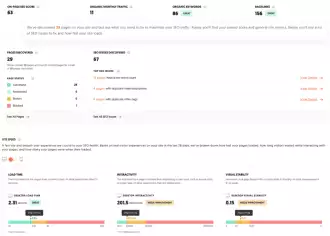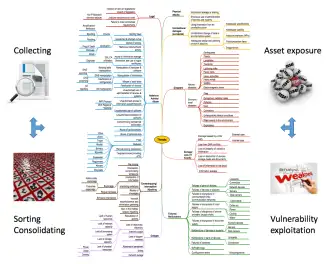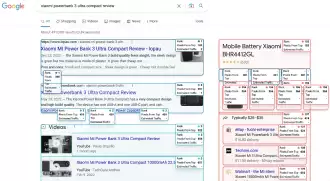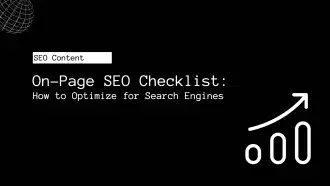The search engine algorithm has revolutionized search engine optimization (SEO) over the years. In fact, search engine algorithms have become more advanced and user-friendly over time. As a result, search engine rankings are constantly changing, making it imperative for website owners to remain on top of things.
One of the primary ways website owners does this is by creating taxonomies and implementing them strategically on their websites. In this blog post, we’re going to talk about taxonomy and how it should ideally be implemented in your website to improve search engine rankings.
What is site taxonomy?
Site taxonomy is the way a website organizes its content and classifies its pages in a hierarchical structure. It is a critical aspect of digital marketing and organic search efforts, as it helps to provide structure to your content and organize it into categories.
Generally, site taxonomy is arranged in a hierarchical structure, with the most important pages located at the top of the hierarchy. This helps visitors find relevant information quickly and easily.
Taxonomy is a real scientific discipline that analyzes the criteria and logical order of classification and hierarchy of elements. It has applications in many fields, including website optimization.
In website development, taxonomies are used to structure the content for ease of navigation and searchability across different platforms (for example, desktop vs. mobile). They help website owners organize content into categories and subcategories, which enhances user experience and boosts rankings on search engines.
Why You Need A User and SEO-Focused Taxonomy
A taxonomy is a hierarchical structure for organizing content and is essential for improving search engine rankings, user experience, and content discovery. Users are accustomed to searching engine rankings based on keyword rankings, and taxonomies can help guide their search by helping businesses organize content in a way that aligns with user expectations.
Taxonomies help businesses structure content in a way that makes it easy to find and access specific types of content, such as product categories and subcategories. They also make it easy for search engine spiders and users to navigate an index page or website.
When creating taxonomies, businesses should consider the purpose of the taxonomy and the types of content they are trying to categorize. Additionally, they should consider the hierarchy of the taxonomy and whether it’s best suited for hierarchical or flat taxonomies.
Finally, they should consider how frequently each category will be used and whether there are any subcategories or categories with a special purpose.
Request Free Review
We start by reviewing your website and then take a look at your current ranking in SERPs.
- Unlock Your Website’s Potential with Our Comprehensive Analysis.
- Outrank Your Competitors with Our Expert Insights and Recommendations.
- Ways for increasing website traffic.
- Get Tailored Recommendations to Achieve Better Results Online.

Focus on topics, not keywords
By having a well-defined taxonomy structure in place, you can ensure that your pages are organized in a way that makes it easier for search engines to crawl and index them. When optimizing your site taxonomy, it is important to focus on topics rather than keywords. This will ensure that multiple keywords are included per section, rather than just one word or phrase.
Additionally, the taxonomy should include terms that accurately describe the content, as this will help search engines identify the topic of the page. Finally, it is important to use both categories and tags when organizing content within the taxonomy, as this will help provide further structure and hierarchy to your pages.
Search Engines Need Structure To Be Effective and Efficient
Search engine optimization (SEO) requires search engines to have structure to be effective and efficient. Internal search engine structure involves organizing search results and keyword metadata in a way that is relevant and useful for users.
This structure must be consistent across search engine results pages (SERPs) and include internal search engine-specific metrics such as the page title, description, and keyword list. SEO also requires an external search engine structure, which involves organizing search results from different search engines in a way that is relevant and useful for users.
Search engine taxonomy and structure are essential for search engines to easily navigate content on websites and index it properly. A hierarchical taxonomy can organize websites into categories based on category hierarchy with low levels of hierarchy. When creating a hierarchical taxonomy, it is important to consider factors such as the type of content, acronyms, and research data for keywords. Search engine opti
How to optimize site taxonomies for SEO
Optimizing site taxonomies is an essential part of SEO success. With the right approach, you can ensure that your website is properly organized, improving your site architecture and helping you achieve better search engine results. Here’s how to get started:
1. Develop User Profiles or Proto-Personas: Before you start to optimize your taxonomy structure, it’s important to understand what keywords users are after and what kind of content they’re looking for. Developing user profiles (or proto-personas) is a great way to gain this understanding.
2. Use A Hierarchical Taxonomy: This taxonomy structure is often used for larger websites. In a hierarchal taxonomy, there are parent and child pages that are connected in a hierarchy-like structure. This allows you to organize your content in a way that makes it easier for users and search engines to find.
3. Perform Keyword Research: Keyword research is fundamental for taxonomy development. By understanding search patterns, you can gain insight into the market, which can help you create an effective site taxonomy that takes into account user intent and the content they’re after.
4. Optimize Categories for Brand, Make & Model: When you’re creating categories and subcategories, make sure that they are optimized for their specific brand, make & model and linked to the main “bathing suit” category page. That way your category pages will be more visible in search engine results pages (SERPs).
By following these steps, you can create an effective site taxonomy that will improve your website’s structure, making it easier for users to find the information they need and helping you achieve better SEO results.
Request Free Review
We start by reviewing your website and then take a look at your current ranking in SERPs.
- Unlock Your Website’s Potential with Our Comprehensive Analysis.
- Outrank Your Competitors with Our Expert Insights and Recommendations.
- Ways for increasing website traffic.
- Get Tailored Recommendations to Achieve Better Results Online.

SEO category pages
Taxonomy SEO is the process of optimizing website pages for search engines based on their organizational structure, such as categories and tags. The category page should be relevant to the content of the page, and a hierarchy of categories should be established to help users quickly find relevant content. Categories must be relevant and hierarchical, with subcategories relevant to subcategories. Redundant categories or categories that are not relevant should be removed to ensure optimal taxonomy optimization.
Poor website taxonomies can negatively impact search engine rankings, so it is important to avoid this problem when starting an SEO audit. Connecting to Google accounts and understanding the SEO audit process can help improve site taxonomy and ensure keyword-rich content is properly categorized.
SEO tag pages
SEO tag pages are an essential part of any website’s taxonomy structure. They provide users with the ability to search for and find content relevant to specific keyword categories. SEO tag pages help search engine bots understand how content on a website relates to one another and can be useful in improving rankings in search results. In addition, SEO tag pages can be optimized to improve the structure of a website and make it easier to navigate for users.
Creating a hierarchical taxonomy that includes the full semantic relationship between topical entities can help maximize SEO value. When optimizing website taxonomies, it’s important to avoid creating taxonomies with duplicate categories or categories with overlapping subcategories. This will only increase page load times and reduce user experience.
SEO faceted navigation
SEO professionals can use faceted navigation to create hierarchical taxonomies for their site. Faceted navigation allows users to filter content by different criteria, such as price, weight, and color. This type of navigation can help search engines understand the content on your website and improve rankings.
Taxonomy SEO is a process of organizing website content in a way that makes it easier for Google to understand and rank. By effectively using taxonomy SEO with faceted navigation, you can improve website ranking and increase traffic to your site. The best way to optimize taxonomy with faceted navigation is by adding text and images, updating common SEO elements, creating excerpts, and understanding site architecture.
The benefits of website taxonomy
Website taxonomies are an essential part of website architecture and help to make a website easier to navigate and find the information users are looking for. These taxonomies can be hierarchical and include the full semantic relationship between your top-level entities, thereby providing structure and context to the content on a page.
Additionally, website taxonomies provide a way to categorize content in a search engine-friendly manner, which can help to improve rankings. Setting up the right taxonomy for a website can significantly impact the site’s architecture, making it easy to navigate and understand. This can help users find the information they need in an efficient manner, increasing user engagement and search engine rankings.
Metadata
Metadata is vital to creating high-quality content on a website and optimizing it for search engine optimization.
- Met- taglines and titles are crucial to ensuring that a page’s content is relevant and keyword-rich.
- Met-taglines and titles also help search engine bots understand what content on your page is relevant and keyword-rich.
- Also important are descriptions and body text of pages, which provide additional information about the content on that page.
- By using taxonomy in your website’s structure, you create content hierarchy, which makes it easier for search engine bots to understand the content on your website. This helps create link juice, or the value of a hyperlink to a page on your website.
- A well-o-m-ed site structure also allows users to easily find relevant content and provides search engine bots with clear navigation paths. This enhances user experience and boosts ranking in search results.
A well-o-m-ed site structure also helps users find relevant content and provides search engine bots with clear navigation paths, enhancing user experience and boosting ranking in search results
Type of metadata
Meta titles and meta descriptions are often used to drive page rankings in search results. Besides, excerpting relevant content from blog post can help present relevant information in a concise manner for SEO optimization purpose. HTML markup, tags, and site structure all affect SEO. Long-tail keywords help search engines identify user queries’ intent, while categories and tags allow website category management system
How WordPress Uses Taxonomies
Taxonomies are a way of organizing content on your website into related groups. By default, WordPress comes with two taxonomies: categories and tags. Categories are more general, while tags are more specific. You can also create custom taxonomies to further organize your content.
Using Categories in WordPress
Categories are the simplest way to organize your content into related groups. When creating a new post or page, you can assign it to one or more categories, making it easier for visitors to find relevant content. You can also add a category widget to your sidebar so that visitors can quickly access all the content you’ve organized into categories.
Using Tags in WordPress
Tags are a more specific way of categorizing your content than categories. While categories can be used to group together similar posts, tags allow you to further differentiate between posts within the same category. For example, if you had a category for “Recipes”, you could use tags such as “Italian” or “Vegetarian” to further organize the recipes within that category. Just like with categories, when creating a new post you can assign one or more tags to it. You can also add a tag cloud widget to your sidebar so that visitors can easily find all the posts that have been tagged with the same keyword.
Creating Custom Taxonomies in WordPress
If the default categories and tags aren’t enough for organizing your content, you can create custom taxonomies as well. Custom taxonomies allow you to create more specific types of groups so that you can better organize your content according to your needs. For example, you could create a custom taxonomy for books so that you can group them by genre or author name. To create custom taxonomies, you’ll need a plugin such as Custom Post Type UI or Custom Taxonomy Manager.
What are Custom Post Types in WordPress?
Custom post types are a method of displaying certain types of content on a website, such as recipes or case studies. They can be created with the help of various plugins and allow for additional fields and taxonomies, which can be used to organize different types of post on a website. Custom post types are often seen in sidebars and footers of blog posts, as they allow users to easily find relevant content.
Taxonomies are categories that can be used to organize WordPress posts and pages. They are often ignored in search results, as Google favors high-quality pages, posts, and recipes. However, search engine optimization (SEO) experts can help identify pages with high-quality content to improve search rankings.
Custom Post Types Can Have Their Own Taxonomies
Custom post types in WordPress allow you to display a specific type of content, such as a recipe or case study, on your website. Custom post types can also have their own taxonomies to categorize different content. For example, each category of a recipe may have its own taxonomy. Additional taxonomies can be created for Custom Post Types such as Recipes with categories like Cuisine Type, Meal Type, Level of Difficulty, and Dietary Restrictions. These taxonomies are often ignored in search results as Google prioritizes Pages, Posts, and Recipes with high-quality content. Therefore, creating taxonomies for Custom Post Types is crucial for keyword-rich content on your website.
Site taxonomy tool
The best site taxonomy tool is one that helps you organize your content assets in a way that improves your site architecture and SEO. Protege is an open source ontology manager that is a great tool for creating and managing a taxonomy scheme. It allows you to export to SKOS, a W3C standard, for compatibility with other tools. Classr’s Taxonomy Builder is another great option as it allows for easy creation of multi-level category trees. Auto-categorization and keyword research tools can also be used to help optimize your website taxonomy. With the right tool, you can ensure your website is organized in a logical manner so users can easily find the information they need.
Request Free Review
We start by reviewing your website and then take a look at your current ranking in SERPs.
- Unlock Your Website’s Potential with Our Comprehensive Analysis.
- Outrank Your Competitors with Our Expert Insights and Recommendations.
- Ways for increasing website traffic.
- Get Tailored Recommendations to Achieve Better Results Online.

Frequently Asked Questions
What is site taxonomy?
Site taxonomy is the classification of something, commonly used by websites to organize content on their website. This can include categories (like “Products” on a website), subcategories (like “Shoes” under “Clothing”), or even specific tags (like “Women’s Shoes”).
Website taxonomy is used to make content easier to navigate and understand. A website taxonomy should be planned and implemented by an SEO specialist in order to ensure that pages are structure in categories or tags based on the website’s conceptual organization. URLs are structured based on the website’s taxonomy.
Does taxonomy help with SEO?
Yes, taxonomy can help with search engine optimization (SEO). website taxonomy structure is important for SEO as it helps search engines crawl the content on the site and index it properly. Poor taxonomy structure can include keywords, metadata, content, and site taxonomy. However, good taxonomy structure can create opportunities for optimization, such as with a database of products, including Price, Weight, Color and intangibles.
Does taxonomy affect SEO?
Yes, taxonomy affects SEO. Taxonomy SEO is the process of optimizing pages on a website based on the organizational structure of the content, such as categories and tags. Improving taxonomy can help increase website ranking in Google and increase traffic. In addition, site taxonomy, or site structure, is an important factor in SEO, as it can help search engines better crawl the content on a website. Taxonomy SEO includes updating common SEO elements, like Meta Titles and Meta Descriptions, and understanding site architecture. Database of Products might have its own hierarchical taxonomy, including Price, Weight, Color and intangibles, which provides an opportunity for optimization.
How do I create a website taxonomy?
Creating website taxonomies involves categorizing content into subtopics. Once you have categorized the content, you then need to map it to the buyers’ funnel. This will help you determine where the page content is most relevant and target it with search engine optimization (SEO).
A website’s URL structure should reflect the page’s position in the website’s taxonomy. This way, search engine results pages (SERPs) will show the page content that is relevant to the user’s search criteria.
An SEO specialist is responsible for good planning and effective implementation of website taxonomies. They make sure that the website’s taxonomy is well-planned and implemented correctly, thereby improving organic search engine ranking.
Is your website taxonomy currently optimized for SEO?
Yes, most modern website taxonomy is currently optimized for SEO. By optimizing for taxonomy SEO, you can add additional content, update common SEO elements, create excerpts, and understand site architecture in order to make your content more search engine friendly. Additionally, taxonomy SEO can help improve a site’s ranking in Google and increase traffic to pages.
Conclusion
To structure content and make it search-friendly, website taxonomies are used. They allow website visitors to organize content on the website in a hierarchical system.
Search engine bots can readily use taxonomies to search websites and find relevant content more efficiently. Besides, website taxonomies ensure that website content is structured in an organized manner, making it easier for search engine bots to understand and index website content.
However, it is crucial that site taxonomies are user-friendly and well-structured. If not, user-friendliness and search engine optimization (SEO) results can suffer drastically. To structure your website’s page hierarchy effectively, we suggest using a taxonomy-based site structure tool like Yoast’s WordPress site structure tool or another one of your choice.



